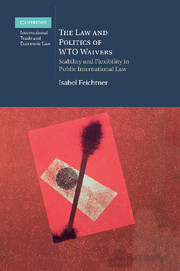Book contents
- Frontmatter
- Contents
- Acknowledgements
- 1 Why study the WTO waiver?
- Part I The stability/flexibility challenge in public international law and particularly the WTO
- Part II The practice and law of waivers
- Part III The potential of waivers to address the stability/flexibility challenge in international law
- Bibliography
- Index
Part II - The practice and law of waivers
Published online by Cambridge University Press: 05 December 2011
- Frontmatter
- Contents
- Acknowledgements
- 1 Why study the WTO waiver?
- Part I The stability/flexibility challenge in public international law and particularly the WTO
- Part II The practice and law of waivers
- Part III The potential of waivers to address the stability/flexibility challenge in international law
- Bibliography
- Index
Summary
The practice and law of waivers
In the next chapter I first introduce the waiver power and its history. I proceed to analyse the waiver practice under the GATT 1947 and in the WTO in order to determine which flexibility demands have in fact been addressed by the waiver power (Chapter 4). The subsequent chapter presents an account of the law of waivers as it is laid down in legal instruments and as it emerged from the institutional practice (Chapter 5). Both chapters form the basis for the analysis in Part III as to the potential of the waiver to provide flexibility in order to meet individual and collective needs and preferences.
- Type
- Chapter
- Information
- The Law and Politics of WTO WaiversStability and Flexibility in Public International Law, pp. 57Publisher: Cambridge University PressPrint publication year: 2011

